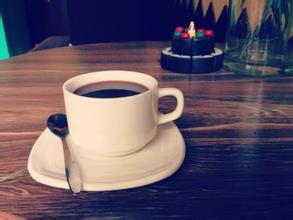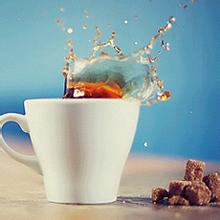Introduction to the production and brewing methods of Yunnan small-grain coffee beans in manor area
Introduction to the production and brewing methods of Yunnan small-grain coffee beans in manor area
1) add an appropriate amount of pure water to the lower seat of the siphon kettle (heated pure water can be used to shorten the time of boiling water. In this operation, the amount of water added is 2.5 cups, that is, about 280 milliliters, two cups of water is for guests / friends, and the extra half cup is for the brewers to taste in advance. If the taste is abnormal at that time, do not give it to the guests, hehe)
2) when there is enough fuel in the alcohol lamp, ignite it and place it directly under the lower seat of the siphon kettle.
3) fix the filter with filter cloth / filter paper on the upper seat of the siphon kettle and make sure that the position of the filter is in the center (if the position is off, it can be adjusted with a bamboo stirring rod)
4) pour the right amount of coffee powder (2.5 cups of water corresponds to about 37 grams of coffee powder, which can be adjusted according to your taste) into the upper seat of the siphon pot. Shake the upper seat horizontally so that the coffee powder is evenly covered with the filter
5) insert the upper seat of the siphon pot obliquely into the lower seat, but not tightly (if the upper seat is inserted after the water is boiled, boiling hot water may suddenly erupt, which is quite dangerous, remember!)
6) when the water in the lower seat is boiling completely, move the alcohol lamp away for about 10 seconds, then move it back, but do not put it directly under the lower seat, it should be slightly off the center. This has two purposes: one is to reduce the water temperature to about 95 degrees, and the other is to reduce the firepower of alcohol lamps (as mentioned earlier, alcohol lamps are not very convenient in adjusting firepower. This is also the reason why some people rotate to use two alcohol lamps or gas stoves with adjustable firepower)
7) straighten the upper seat and insert it into the lower seat (with a little force)
8) at this time, due to the increase of pressure after heating, the water in the lower seat will flow into the upper seat along the riser of the upper seat. When there is only 1 / 3 water left in the lower seat, pour the ground coffee powder into the upper seat and pour wet coffee powder from all sides to the middle with a bamboo stick.
9) after the coffee powder is completely wet, start the clock (do not stir the coffee mixture at this time, this stage is called "stew")
10) after about 45 seconds, use a bamboo stick to quickly stir the coffee solution. After a layer of foam appears on the liquid surface, the stirring can be stopped. Wait a few more seconds, and then the alcohol lamp will be removed and extinguished.
11) wipe the lower seat with a wet rag prepared in advance to cool the lower seat; the order of wiping is to wipe the bottom first and then wipe around, and do not stay in one position for too long, lest the lower seat will burst due to uneven cooling. If you are skilled, wipe the lower seat with a rag in one hand and stir the coffee solution with a stirring stick in the other to speed up its cooling.
12) when the lower seat is not as expected, the internal pressure decreases, resulting in the coffee solution in the upper seat being sucked back to the lower seat (this is also the origin of the name of the siphon pot)
13) when the coffee solution in the upper seat is completely sucked back, pull out the upper seat and pour the coffee liquid in the lower seat into a pre-warmed coffee cup.
When the coffee solution in the upper seat is sucked into the lower seat, in the final stage, some foam will be formed above the liquid surface of the lower seat. By observing the shape of the foam, we can judge whether the heat and extraction are appropriate: if there are a large number of fine foams, it shows that the heat of brewing coffee is too large, and the taste of coffee will be quite bitter; if it is a big bubble, and it disappears after a few seconds, it shows that the heat is ideal; if there is almost no foam, it shows that the heat is not enough. If it is found that the heat is not suitable, it can be adjusted by means of increasing or decreasing the time of "stewing" in the future.

Important Notice :
前街咖啡 FrontStreet Coffee has moved to new addredd:
FrontStreet Coffee Address: 315,Donghua East Road,GuangZhou
Tel:020 38364473
- Prev

Which is better, the water system or the sun-dried coffee beans? Introduction to the process of flavor description of treatment method
Which is better, the water system or the sun-dried coffee beans? Treatment Flavor description treatment process introduces that the fruit begins the process of sun drying without treatment after picking. This is the oldest method of treatment in existence. The drying process usually lasts about 4 weeks. The method of handling must be very strict to ensure that the coffee does not lose any flavor. The natural sun method requires the local climate to be extremely dry. In some cases
- Next

Description of characteristics and Flavor of Sun Lion King Coffee beans introduction of Grinding degree in Manor area
Description of the characteristics and flavor of sun-dried Lion King Coffee beans Coffee is the most important export cash crop and the main source of foreign exchange income in Ethiopia. Ethiopia's coffee exports account for about 3% of the world market, making it the eighth largest coffee exporter in the world. Coffee exports increased steadily from 58000 tons in 1990 to 1995-1996.
Related
- Guji coffee producing area of Guji, Ethiopia: Humbela, Shakiso, Wulaga
- What is the most expensive variety of Qiloso in BOP multi-variety group?
- How to store the coffee beans bought home?
- Why are Yemeni coffee beans so rare now?
- Ethiopian Sidamo all Red Fruit Sun Sun Santa Vini Coffee beans
- SOE is mostly sour? What does it mean? Is it a single bean? what's the difference between it and Italian blending?
- Is Italian coffee beans suitable for making hand-brewed coffee?
- How to choose coffee beans when making cold coffee? What kind of coffee beans are suitable for making cold coffee?
- Just entered the pit to make coffee, what kind of coffee beans should be chosen?
- Can only Japan buy real Blue Mountain Coffee? What are authentic Jamaican Blue Mountain coffee beans?

